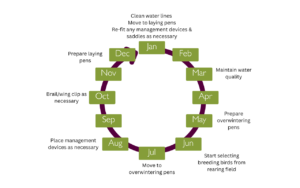As our breeding birds come to the end of their laying cycle for this year, attention turns to selecting birds to overwinter.
In general, the 2025 season has gone well in terms of chick quality in the UK. Following an initial shortage of eggs and a smaller national laying flock, chick numbers were expected to be low. However, the dry spring meant ground laid eggs were clean, which meant hatchability and chick quality has been good. The egg number per hen has been generally high.
What are some of the benefits of overwintering?
- Better bird condition: You can feed and build up the birds, protect them from stressors, check bird health and treat as necessary to help disease challenge
- Better biosecurity with a controlled environment
- Known quality with a closed flock (e.g. mycoplasma status)
- Controlled source and genetics rather than random selection from catching up
- Better acclimatised ready for laying
- Stronger breeding reliability in terms of fertility/bird weight
How do you select laying stock
The birds you choose to breed from will determine the genetics for your rearing site. Generally, pheasants are kept as layers for a year to help keep up fertility and reduce inbreeding. Partridges are monogenous, with natural pairing giving better breeding results versus forced pairing. These pairs can be bred from for two to three years.
Selecting birds from your own stock to overwinter has the benefit of knowing the history of the birds’ health and genetics. Whether you are selecting birds from your own stock or sourcing them from a game farm, it’s important to know what traits to prioritise and what to avoid.
Ideally pick birds and breeds with characteristics of birds you want on site. Generally, these tend to be birds that have been produced earlier in the breeding season, however there is usually high demand for these. They will also be more costly as they will need to be fed and housed for longer. Therefore, many breeders compromise and select birds mid-season.
What to look for in overwintering stock
- Physical traits – good sizes, shape, feather quality, breed and colour
- Temperament – avoid aggressive birds
- Strong immune system – often found in birds from earlier in the season
- Good rearing history – minimal disease issues or development issues
- Good conformation – No deformities or defects
Pheasant breeding flocks
Make sure there is a ratio of at least 1:10 cocks to hen available. Some sites choose to have a few spare for rotation or replacements.
We also recommend introducing some cocks from an alternative source to avoid inbreeding. At least 25%–50% of the males should be from genetically unrelated sources each year. 50% is the ideal however if you want to keep more of your birds’ genetic characteristics, you can move towards the 25% however 25% is the minimum to prevent inbreeding. Whatever your chosen ratio, where you source these new birds from should ideally be changed every two to three years.

As a final reminder, new birds should always be quarantined for a minimum of three weeks before being introducing to a flock.
If you would like any advice on breeding – our vets are on hand to answer any questions you may have. Give us a call on 01392 872932 or email info@stdavids-gamebirds.co.uk


